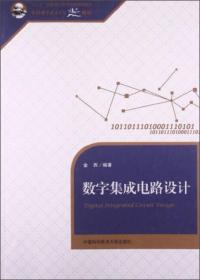
数字集成电路:设计透视第2版
¥ 37.99 5.6折 ¥ 68 九品
仅1件
北京昌平
认证卖家担保交易快速发货售后保障
作者[德]拉贝(Rabaey J.M.) 著
出版社清华大学出版社
出版时间2004-03
版次1
装帧平装
货号A1
上书时间2024-12-15
- 在售商品 暂无
- 平均发货时间 15小时
- 好评率 暂无
- 最新上架
商品详情
- 品相描述:九品
图书标准信息
- 作者 [德]拉贝(Rabaey J.M.) 著
- 出版社 清华大学出版社
- 出版时间 2004-03
- 版次 1
- ISBN 9787302079682
- 定价 68.00元
- 装帧 平装
- 开本 16开
- 纸张 胶版纸
- 页数 761页
- 正文语种 简体中文,英语
- 【内容简介】
- (1)将数字集成电路设计中电路与系统的视角统一起来,在系统深入地介绍了深亚微米条件下半导体器件的知识和最基本的反相器后,作者逐渐将这些基础知识引入到更加复杂的模块,比如门、寄存器、控制器、加法器、乘法器和存储器等。在深亚微米的设计条件下,设计者不仅仅需要考虑整个系统的设计问题,还要随时警惕在电路级——比如器件和连线所带来的问题。(2)本书是第一本将数字集成电路设计问题集中在深亚微米条件下的参考书,并且提供了一个深亚微米条件下的简晶体管模型。另外针对深亚微米条件下设计人员所面对的新挑战,例如互连线问题、信号完整性问题、时钟分布问题、功耗问题等,全书都做了非常详细的论述。(3)书中的内容紧扣当今数字集成电路设计的核心问题,并通过大量的设计实例向读者介绍了最新的设计技术和工程发展现状与趋势。
- 【目录】
-
Chapterl:Introduction
1.1AHistoricalPerspective
1.2IssuesinDigitalIntegratedCircuitDesign
1.3ToProbeFurther
1.4Exercises
PART1:ACIRCUITPERSPECTIVE
Chapter2:TheDevices
2.1Introduction
2.2TheDiode
2.2.1AFirstGlanceattheDevice
2.2.2StaticBehavior
2.2.3Dynamic,orTransient,Behavior
2.2.4TheActualDiode-SecondaryEffects
2.2.5TheSPICEDiodeModel
2.3TheMOS(FET)Transistor
2.3.1AFirstGlanceattheDevice
2.3.2StaticBehavior
2.3.3DynamicBehavior
2.3.4TheActualMOSTransistor-SecondaryEffects
2.3.5SPICEModelsfortheMOSTransistor
2.4TheBipolarTransistor
2.4.1AFirstGlanceattheDevice
2.4.2StalicBehavior
2.4.3DynamicBehavior
2.4.4TheActualBipolarTransistor-SecondaryEffects
2.4.5SPICEModelsfortheBipolarTransistor
2.5AWordonProcessVariations
2.6Perspective:FutureDeviceDevelopments
2.7Summary
2.8ToProbeFurther
2.9ExercisesandDesignProblems
AppendlxA:LayoutDesignRules
AppendlxB:Small-SlgnalModels
Chapter3:TheInverter
3.1Introduction
3.2DelinitionsandProperties
3.2.1AreaandComplexity
3.2.2FunctionalityandRobustness:TheStaticBehavior
3.2.3Performance:TheDynamicBehavior
3.2.4PowerandEnergyConsumption
3.3TheStaticCMOSInvener
3.3.1AFirstGlance
3.3.2EvaluatingtheRobustnessoftheCMOSInverter:TheStaticBehavior
3.3.3PerfonnanceofCMOSInverter:TheDynamicBehavior
3.3.4PowerConsumptionandPower-DelayProduct
3.3.5ALookintotheFuture:EffectsofTechnologyScaling
3.4TheBipolarECLInverter
3.4.1IssuesinBipolarDigitalDesign:ACaseStudy
3.4.2TheEmitter-CoupledLogic(ECL)GateataGlance
3.4.3RobustnessandNoiseImmunity:TheSteady-StateCharacteristics
3.4.4ECLSwitchingSpeed:ThcTransientBehavior
3.4.5PowerConsumption
3.4.6LookingAhead:ScalingtheTechnology
3.5Perspective:Area,Perfonnance,andDissipation
3.6Summary
3.7ToProbeFurther
3.8ExercisesandDesignProblems
Chapter4:DesigningCombinationalLogkCatesinCMOS
4.1Introduction
4.2StaticCMOSDesign
4.2.1ComplementaryCMOS
4.2.2RatioedLogic
4.2.3Pass-TransistorLogic
4.3DynamicCMOSDesign
4.3.1DynamicLogic:BasicPrinciples
4.3.2PerfonnanceofDynamicLogic
4.3.3NoiseConsiderationsinDynamicDesign
4.3.4CascadingDynamicGates
4.4PowerConsumptioninCMOSGates
4.4.1SwitchingActivityofaLogicGate
4.4.2GlitchinginStaticCMOSCircuits
4.4.3Short-CircuitCurrentsinStaticCMOSCircuits
4.4.4AnalyzingPowerConsumptionUsingSPICE
4.4.5Low-PowerCMOSDesign
4.5Perspective:HowtoChooseaLogicStyle
4.6Summary
4.7ToProbeFurther
4.8ExercisesandDesignProblems
AppendixC:LayoutTechniquesforComplexCates
Chapter5:VeryHighPerfonnanceDigitalCircuits
5.1Introduction
5.2BipolarGateDesign
5.2.1LogicDesigninECL
5.2.2DifferentialECL
5.2.3CurrentModeLogic
5:2.4ECLwithActivePull-Downs
5.2.5AltemativeBipolarLogicStyles
5.3TheBiCMOSApproach
5.3.1TheBiCMOSGateataGlance
5.3.2TheStaticBehaviorandRobustnessIssues
5.3.3PerfonnanceoftheBiCMOSInverter
5.3.4PowerConsumption
5.3.5TechnologyScaling
5.3.6DesigningBiCMOSDigitalGates
5.4DigitalGalliumArsenideDesign*
5.4.1GaAsDevicesandTheirProperties
5.4.2GaAsDigitalCircuitDesign
5.5Low-TemperatureDigitalCircuits*
5.5.1Low-TemperatureSiliconDigitalCircuits
5.5.2SuperconductingLogicCircuits
5.6Perspective:WhentoUseHigh-PerformanceTechnologies
5.7Summary
5.8ToProbeFurther
5.9ExercisesandDesignProblems
AppendlxD:TheSchottky-BamerOiode
Chapter6:DesigningSequentialLogicCircuits
6.1Introduction
6.2StaticSequentialCircuits
6.2.1Bistability
6.2.2Flip-FlopClassification
6.2.3Master-SlaveandEdge-TriggeredFFs
6.2.4CMOSStaticFlip-Flops
6.2.5BipolarStaticFlip-Flops
6.3DynamicSequentia)Circuits
6.3.1ThePseudostaticLatch
6.3.2TheDynamicTwo-PhaseFlip-Flop
6.3.3TheC2MOSLatch
6.3.4NORA-CMOS-ALogicStyleforPipelinedStructures
6.3.5TrueSingle-PhaseClockedLogic(TSPCL)
6.4Non-BistableSequentialCircuits
6.4.1TheSchmittTrigger
6.4.2MonostableSequentialCircuits
6.4.3AstableCircuits
6.5Perspective:ChoosingaClockingStrategy
6.6Summary
6.7ToProbeFunher
6.8ExercisesandDesignProblems
PART11:ASYSTEMSPERSPECTIVE
Chapter7:DesigningArithmeticBuildingBlocks
7.1Introduction
7.2DatapathsinDigitalProcessorArchitectures
7.3TheAdder
7.3.1TheBinaryAdder:Definitions
7.3.2TheFullAdder:CircuitDesignConsiderations
7.3.3TheBinaryAdder:LogicDesignConsiderations
7.4TheMultiplier
7.4.1TheMultiplier:Definitions
7.4.2TheArrayMultiplier
7.4.3OtherMultiplierStructures
7.5TheShifter
7.5.1BarrelShifter
7.5.2LogarithmicShifter
7.6OtherArithmeticOperators
7.7PowerConsiderationsinDatapathStructures
7.7.1ReducingtheSupplyVoltage
7.7.2ReducingtheEffectiveCapacitance
7.8Perspective:De.signasaTrade-off
7.9Summary
7.10ToProbeFurther
7.11ExercisesandDesignProblems
AppendixE:FromDatapathSchematicstoLayout
Chapter8:CopingwlthInterconnect
8.1Introduction
8.2CapacitiveParasitics
8.2.1ModelingInterconnectCapacitance
8.2.2CapacitanceandReliability-CrossTalk
8.2.3CapacitanceandPerformanceinCMOS
8.2.4CapacitanceandPerformanceinBipolarDesign
8.3ResistiveParasitics
8.3.1ModelingandScalingofInterconnectResistance
8.3.2ResistanceandReliability-OhmicVoltageDrop
8.3.3Electromigration
8.3.4ResistanceandPerformance-RCDelay
8.4InductiveParasitics
8.4.1SourcesofParasiticInductances
8.4.2InductanceandReliability-VoltageDrop
8.4.3InductanceandPerformance-TransmissionLin5eEffects
8.5CommentsonPackagingTechnology
8.5.1PackageMaterials
8.5.2InterconnectLevels
8.5.3ThennalConsiderationsinPackaging
8.6Perspective:WhentoConsiderInterconnectParasitics
8.7ChapterSummary
8.8ToProbeFurther
8.9ExercisesandDesignProblems
Chapter9:TimingIssuesinDigitalCircuits
9.1Introduction
9.2ClockSkewandSequentialCircuitPerformance
9.2.1Single-PhaseEdge-TriggeredClocking
9.2.2Two-PhaseMaster-SlaveClocking
9.2.3OtherClockingStyles
9.2.4HowtoCounterClockSkewProblems
9.2.5CaseStudy-TheDigitalAlpha21164Microprocessor
9.3Self-TimedCircuitDesign*
9.3.1Selt-TimedConcept
9.3.2Completion-SignalGeneration
9.3.3Self-TimedSignaling
9.4SynchronizersandArbiters*
9.4.1Synchronizers-ConceptandImplementation
9.4.2Arbiters
9.5ClockGenerationandSynchronization*
9.5.1ClockGenerators
9.5.2SynchronizationattheSystemLevel
9.6Perspective:SynchronousversusAsynchronousDesign
9.7Summary
9.8ToProbeFurther
9.9Exerci.sesandDesignProblems
Chapter10:DesigningMemoryandArrayStructures
10.1Introduction
10.2SemiconductorMemories--AnIntroduction
10.2.1MemoryClassification
10.2.2MemoryArchitecturesandBuildingBlocks
10.3TheMemoryCore
10.3.1Read-OnlyMemories
10.3.2NonvolatileRead-WriteMemories
10.3.3Read-WriteMemories(RAM)
10.4MemoryPeripheralCircuitry
10.4.1TheAddressDecoders
10.4.2SenseAmplifiers
10.4.3Drivers/Buffers
10.4.4TimingandControl
10.5MemoryReliabilityandYield
10.5.1Signal-To-NoiseRatio
10.5.2Memoryyield
10.6CaseStudiesinMemoryDesign
10.6.1TheProgrammableLogicArray(PLA)
10.6.2A4MbitSRAM
10.7Perspective:SemiconductorMemoryTrendsandEvolutions
10.8Summary
10.9ToProbeFurther
10.10ExercisesandDesignProblems
Chapterll:DeslgnMethodologles
11.1Introduction
11.2DesignAnalysisandSimulation
11.2.1RepresentingDigitalDataasaContinuousEntity
11.2.2RepresentingDataasaDiscreteEntity
11.2.3UsingHigher-LevelDataModels
11.3DesignVerification
11.3.1ElectricalVerification
11.3.2TimingVerification
11.3.3Functional(orFonnal)Verification
11.4ImplementationApproaches
11.4.1CustomCircuitDesign
11.4.2Cell-BasedDesignMethodology
11.4.3Anay-BasedImplementationApproaches
11.5DesignSynthesis
11.5.1CircuitSynthesis
11.5.2LogicSynthesis
11.5.3ArchitectureSynthesis
11.6ValidationandTestingofManufacturedCircuits
11.6.1TestProcedure
11.6.2DesignforTestability
11.6.3Test-PattemGeneration
11.7PerspectiveandSummary
11.8ToProbeFurther
11.9ExercisesandDesignProblems
ProblemSolutions
点击展开
点击收起
相关推荐
— 没有更多了 —






















以下为对购买帮助不大的评价